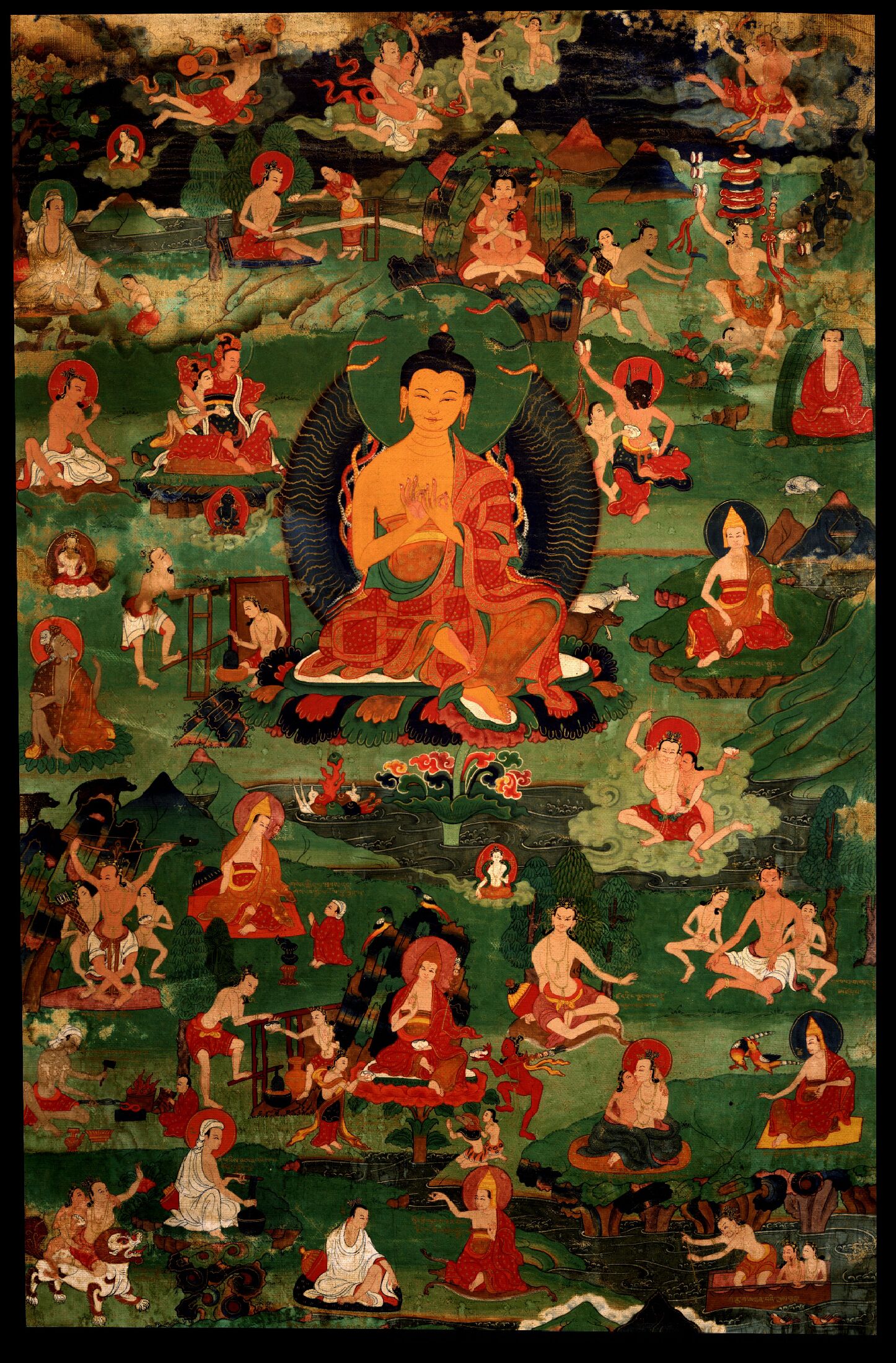|
Prajñaptivāda
The Prajñaptivāda (Sanskrit; ) was a branch of the Mahāsāṃghika, one of the early Buddhist schools in India. The Prajñaptivādins were also known as the ''Bahuśrutīya-Vibhajyavādins''. History According to Vasumitra, the Prajñaptivāda school is said to have developed as one of several Mahāsāṃghika subschools. They are recorded as having taken up residence in the Himalayas. According to Tāranātha, the Prajñaptivādins continued to flourish in Magadha through the Pala Empire as late as the 10th century CE. A. K. Warder writes that the Prajñaptivādins were not known to have left Buddhism's original territory (modern Northeast India, Bengal and Nepal). Doctrines and teachings The ''Samayabhedhoparacanacakra'' records that the doctrines of the Prajñaptivāda school were similar to those of the main Mahāsāṃghika school. Prajñapti According to André Bareau, the name ''Prajñaptivāda'' refers to their doctrine that phenomena are the product of conce ... [...More Info...] [...Related Items...] OR: [Wikipedia] [Google] [Baidu] |
Early Buddhist Schools
The early Buddhist schools refers to the History of Buddhism in India, Indian Buddhist "doctrinal schools" or "schools of thought" (Sanskrit: ''vāda'') which arose out of the early unified Buddhist monasticism, Buddhist monastic community (Sangha (Buddhism), saṅgha) due to various schisms in the history of Buddhism, history of Indian Buddhism. The various splits and divisions were caused by differences in interpretations of the Monasticism, monastic rule (Vinaya), doctrinal differences and also due to simple geographical separation as Buddhism spread throughout the Indian subcontinent. The early Buddhist community initially split into two main Nikāyas (monastic groups, divisions), the Sthavira nikāya, Sthavira ("Elders"), and the Mahāsāṃghika ("Great Community"). This initial split occurred either during the reign of Ashoka, Aśoka (c. 268-232 BCE) or shortly after (historians disagree on the matter). Later, these groups became further divided on doctrinal grounds int ... [...More Info...] [...Related Items...] OR: [Wikipedia] [Google] [Baidu] |
Schools Of Buddhism
The schools of Buddhism are the various institutional and doctrinal divisions of Buddhism, which have often been based on historical sectarianism and the differing teachings and interpretations of specific Buddhist texts. The branching of Buddhism into separate schools has been occurring from ancient times up to the present. The classification and nature of the various doctrinal, philosophical or cultural facets of the schools of Buddhism is vague and has been interpreted in many different ways, often due to the sheer number (perhaps thousands) of different sects, sub-sects, movements, etc. that have made up or currently make up the whole of the Buddhist tradition. The sectarian and conceptual divisions of Buddhist thought are part of the modern framework of Buddhist studies, as well as comparative religion in Asia. Some factors in Buddhist doctrine appear to be consistent across different schools, such as the afterlife, while others vary considerably. From a largely English ... [...More Info...] [...Related Items...] OR: [Wikipedia] [Google] [Baidu] |
Nagarjuna
Nāgārjuna (Sanskrit: नागार्जुन, ''Nāgārjuna''; ) was an Indian monk and Mahayana, Mahāyāna Buddhist Philosophy, philosopher of the Madhyamaka (Centrism, Middle Way) school. He is widely considered one of the most important Buddhist philosophers.Garfield, Jay L. (1995), ''The Fundamental Wisdom of the Middle Way'', Oxford: Oxford University Press. Nāgārjuna is widely considered to be the founder of the Madhyamaka school of Buddhist philosophy and a defender of the Mahāyāna movement. His ''Mūlamadhyamakakārikā'' (''Root Verses on Madhyamaka'', MMK) is the most important text on the Madhyamaka philosophy of Śūnyatā, emptiness. The MMK inspired a large number of commentaries in Sanskrit, Chinese, Tibetan, Korean and Japanese and continues to be studied today. History Background India in the first and second centuries CE was politically divided into various states, including the Kushan Empire and the Satavahana dynasty, Satavahana Kingdom. At ... [...More Info...] [...Related Items...] OR: [Wikipedia] [Google] [Baidu] |
Two Truths Doctrine
The Buddhism, Buddhist doctrine of the two truths (Sanskrit: '','' ) differentiates between two levels of ''satya'' (Sanskrit; Pāli: ''sacca''; meaning "truth" or "reality") in the teaching of Gautama Buddha, Śākyamuni Buddha: the "conventional" or "provisional" (''saṁvṛti'') truth, and the "absolute" or "ultimate" (''paramārtha'') truth. The exact meaning varies between the various Schools of Buddhism, Buddhist schools and Southern, Eastern and Northern Buddhism, traditions. The best known interpretation is from the Madhyamaka, Mādhyamaka school of Mahayana, Mahāyāna Buddhism, whose founder was the 3rd-century History of Buddhism in India, Indian Buddhist monk and philosopher Nagarjuna, Nāgārjuna. For Nāgārjuna, the two truths are ''epistemological truths''. The phenomenal world is accorded a provisional existence. The character of the phenomenal world is declared to be neither real nor unreal, but logically indeterminable. Ultimately, Śūnyatā, all phenomena are ... [...More Info...] [...Related Items...] OR: [Wikipedia] [Google] [Baidu] |
Mahāsāṃghika
The Mahāsāṃghika (Brahmi script, Brahmi: 𑀫𑀳𑀸𑀲𑀸𑀁𑀖𑀺𑀓, "of the Great Sangha (Buddhism), Sangha", ) was a major division (nikāya) of the early Buddhist schools in India. They were one of the two original communities that emerged from the first schism of the Pre-sectarian Buddhism, original pre-sectarian Buddhist tradition (the other being the Sthavira nikāya, Sthavira nikaya). This schism is traditionally held to have occurred after the Second Buddhist council, which occurred at some point during or after the reign of Kalashoka. The Mahāsāṃghika nikāya developed into numerous sects which spread throughout History of India, ancient India. Some scholars think that the Mahāsāṃghika Vinaya (Monasticism, monastic rule) represents the oldest Buddhist monastic source, although some other scholars think that it is not the case. While the Mahāsāṃghika tradition is no longer in existence, many scholars look to the Mahāsāṃghika tradition as an ea ... [...More Info...] [...Related Items...] OR: [Wikipedia] [Google] [Baidu] |
Sanskrit
Sanskrit (; stem form ; nominal singular , ,) is a classical language belonging to the Indo-Aryan languages, Indo-Aryan branch of the Indo-European languages. It arose in northwest South Asia after its predecessor languages had Trans-cultural diffusion, diffused there from the northwest in the late Bronze Age#South Asia, Bronze Age. Sanskrit is the sacred language of Hinduism, the language of classical Hindu philosophy, and of historical texts of Buddhism and Jainism. It was a lingua franca, link language in ancient and medieval South Asia, and upon transmission of Hindu and Buddhist culture to Southeast Asia, East Asia and Central Asia in the early medieval era, it became a language of religion and high culture, and of the political elites in some of these regions. As a result, Sanskrit had a lasting effect on the languages of South Asia, Southeast Asia and East Asia, especially in their formal and learned vocabularies. Sanskrit generally connotes several Indo-Aryan languages# ... [...More Info...] [...Related Items...] OR: [Wikipedia] [Google] [Baidu] |
Merit (Buddhism)
Merit (; ) is a concept considered fundamental to Buddhist ethics. It is a beneficial and protective force which accumulates as a result of good deeds, acts, or thoughts. Merit-making is important to Buddhist practice: merit brings good and agreeable results, determines the quality of the next life and contributes to a person's growth towards enlightenment. In addition, merit is also shared with a deceased loved one, in order to help the deceased in their new existence. Despite modernization, merit-making remains essential in traditional Buddhist countries and has had a significant impact on the rural economies in these countries. Merit is connected with the notions of purity and goodness. Before Buddhism, merit was used with regard to ancestor worship, but in Buddhism it gained a more general ethical meaning. Merit is a force that results from good deeds done; it is capable of attracting good circumstances in a person's life, as well as improving the person's mind and inne ... [...More Info...] [...Related Items...] OR: [Wikipedia] [Google] [Baidu] |
Nikaya Buddhism
The term Nikāya Buddhism was coined by Masatoshi Nagatomi as a non-derogatory substitute for Hinayana, meaning the early Buddhist schools. Examples of these groups are pre-sectarian Buddhism and the early Buddhist schools. Some scholars exclude pre-sectarian Buddhism when using the term. The term Theravāda refers to Buddhist practices based on these early teachings, as preserved in the Pāli Canon. Etymology ''Nikāya'' is a Pali word meaning "group" or "assemblage", referring to the collection of early Buddhist schools or non-Mahayana schools. In Indian Buddhism Overview Early Buddhism in India is generally divided into various monastic fraternities, or nikāyas. Conventionally numbering eighteen, the actual count varied over time. The doctrinal orientation of each school differed somewhat, as did the number of piṭakas in their canon. An example of this is the Dharmaguptaka, which included a Bodhisattva Piṭaka and a Dhāraṇī Piṭaka. In the Mahāsāṃghik ... [...More Info...] [...Related Items...] OR: [Wikipedia] [Google] [Baidu] |
Kaccānagotta Sutta
The ''Kaccānagotta Sutta'' is a short, but influential Buddhist text in the Pali Canon (''Saṃyutta Nikāya'' 12.15). A Sanskrit and Chinese (''Saṃyuktāgama'' 301; also a partial quotation in SĀ 262) parallel text is also extant. Although there is considerable agreement across versions, the Sanskrit and Chinese texts are more or less identical to each other and both slightly different from the Pāli version. The Chinese translation was carried out by Guṇabhadra (c. 435-443 CE) as part of a '' Samyuktāgama Sutta'' (雜阿含經) translation project. Guṇabhadra is thought to have had the Sanskrit text brought to China from Sri Lanka. A separate Sanskrit text, also part of the fragmentary ''Saṃyuktāgama'' and dating from the 13th or 14th century, has been preserved. The text is cited in Sanskrit in works by Nāgārjuna and his commentators. Nāgārjuna's citation suggests he had a different version from the extant Sanskrit. The text is also cited in a number of other ... [...More Info...] [...Related Items...] OR: [Wikipedia] [Google] [Baidu] |
Mūlamadhyamakakārikā
The ''Mūlamadhyamakakārikā'' (), abbreviated as ''MMK'', is the foundational text of the Madhyamaka school of Mahāyāna Buddhist philosophy. It was composed by the Indian philosopher Nāgārjuna (around roughly 150 CE).Siderits and Katsura (2013), p. 1. The MMK makes use of reductio arguments to show how ''all'' phenomena ('' dharmas'') are empty of '' svabhava'' (which has been variously translated as essence, own-being, or inherent existence). The MMK is widely regarded as one of the most influential and widely studied texts in the history of Buddhist philosophy. The MMK had a major impact on the subsequent development of Buddhist thought, especially in Tibetan Buddhism and East Asian Buddhism. Background The MMK is the work of Nāgārjuna, an Indian Buddhist monk and philosopher writing in Sanskrit. Very little is known about this figure, including exactly where he lived (somewhere in the Indian subcontinent), exactly what time (some time around the 2nd or 3rd century ... [...More Info...] [...Related Items...] OR: [Wikipedia] [Google] [Baidu] |
Prajñā (Buddhism)
() or () is a Buddhist term often translated as "wisdom", "insight", "intelligence", or "understanding". It is described in Buddhist texts as the understanding of the true nature of phenomena. In the context of Buddhist meditation, it is the ability to understand the three characteristics of all things: ("impermanence"), ("dissatisfaction" or "suffering"), and ("non-self" or "egolessness"). Mahāyāna texts describe it as the understanding of ("emptiness"). It is part of the Threefold Training in Buddhism, and is one of the ten of Theravāda Buddhism and one of the six Mahāyāna . Etymology is often translated as "wisdom", but according to Buddhist bioethics scholar Damien Keown, it is closer in meaning to "insight", "non-discriminating knowledge", or "intuitive apprehension". The component parts of the word are: ; ''Pra'' () : an intensifier which can be translated as "higher", "greater", "supreme" or "premium", or "being born or springing up", referring to a spon ... [...More Info...] [...Related Items...] OR: [Wikipedia] [Google] [Baidu] |






